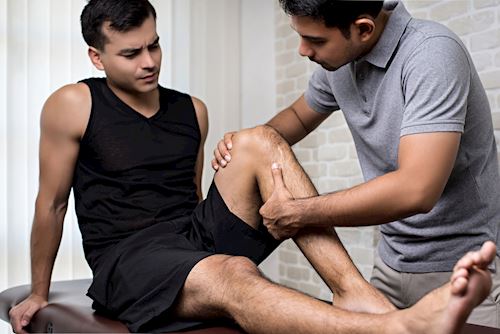1. A rupture or tear of the anterior cruciate ligament is one of the most common sports-related injuries. Usually a non-contact injury, the tear occurs from turning or changing direction on a weight-bearing leg. Usually, the injured person feels a snap or a pop in the knee.
2. Symptoms include swelling that is immediate or within 4 hours of the injury. The athlete may feel they can return to the sport shortly after the injury, only to have the leg collapse again. The patient will not be able to fully extend the knee.
3. Diagnosis can be made by the Anterior Drawer, Lachman, and Pivot Shift Tests. An MRI may be necessary if the knee is too swollen to perform the field tests or if the clinician wishes to obtain further information as to the extent of the injury.
4. Treatment may consist of a conservative or non-conservative approach. The conservative approach consists of extensive physical therapy to strengthen the knee, but no surgery is performed. This approach is often best for an older or non-athletic patient. If surgery is not performed, the patient runs the risk of arthritis and further knee injury. The non-conservative approach requires surgery to replace the ACL ligament. The ligament is often replaced with a graft from the patellar tendon. Surgery is followed by extensive physical therapy. See Operative and Nonoperative treatment of ACL tears
 5. With sufficient time, the prognosis for a surgically repaired ACL tear is good. Most patients can return to full activity 6-9 months after surgery. In most patients, the knee does not reach maximum strength for 1-2 years following surgery.
5. With sufficient time, the prognosis for a surgically repaired ACL tear is good. Most patients can return to full activity 6-9 months after surgery. In most patients, the knee does not reach maximum strength for 1-2 years following surgery.
6. Any athlete that participates in a sport requiring sudden twisting and turning of the knees is at risk for an ACL tear. This injury is common in sports such as football, basketball, skiing, soccer, and gymnastics.
7. A team approach to medicine is very evident in this case. The athletic trainer was responsible for the initial diagnosis and treatment. An MRI of the knee was performed by a radiology technician. The radiologist interpreted the MRI and sent the results to the orthopedic surgeon. This physician confirmed the diagnosis and performed surgery with the help of an operating team consisting of the surgeon, surgical nurses, operating room technicians, and an anesthesiologist. The physical therapist played a key role in this case. Responsibilities of the therapist included a presurgical strengthening program and a rehabilitative, post-surgical program to strengthen the knee and restore full function. The physical therapist worked with Derrick for over a year.
